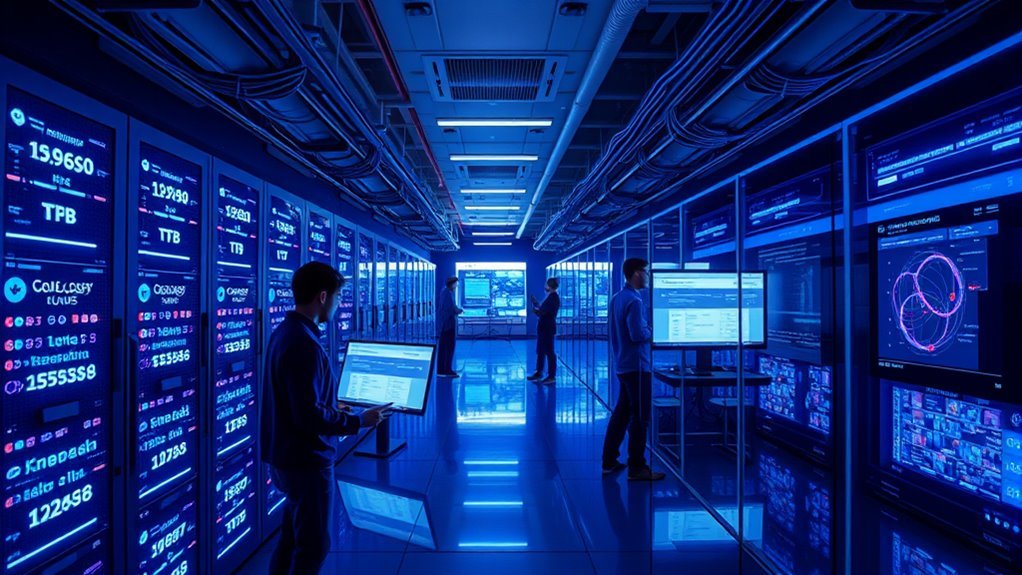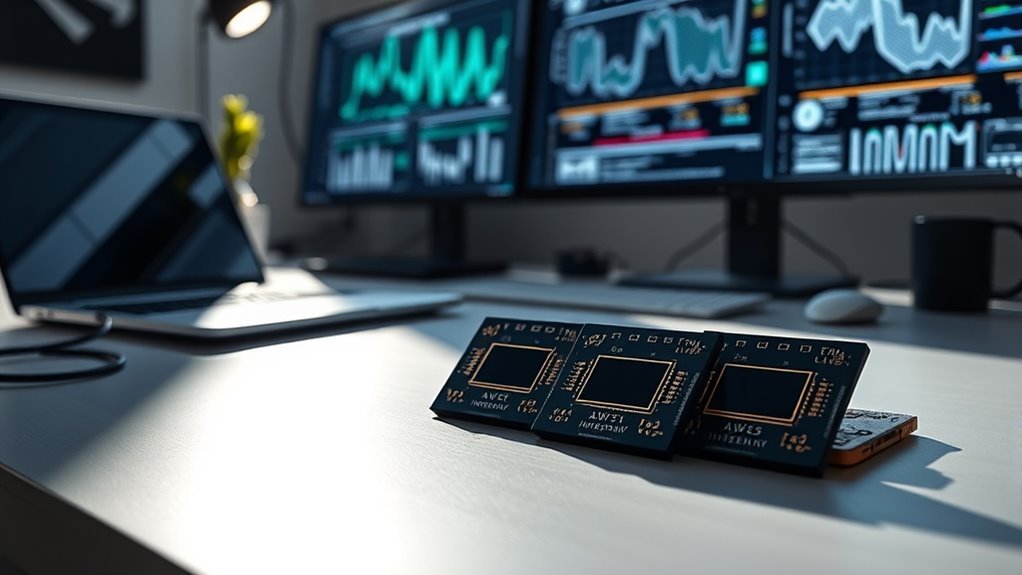You can optimize AI compute with AWS Graviton processors by leveraging their ARM-based architecture tailored for high-performance, energy-efficient workloads. They deliver faster model training, reduced latency, and lower power consumption while cutting costs through better performance per watt. Graviton supports popular AI frameworks like TensorFlow and PyTorch, enabling seamless integration and scalable parallelism. With these enhancements, you gain tighter budget control and sustainable scaling. Exploring deeper reveals practical strategies and real-world impact for your AI deployments.
Understanding AWS Graviton Architecture

The AWS Graviton architecture is designed to deliver high-performance computing with energy-efficient, custom-built Arm processors. When you explore this processor design, you’ll find it’s optimized for scalable workloads, balancing power and efficiency. Graviton architecture employs a multi-core setup, integrating advanced features like improved memory bandwidth and cache hierarchy to accelerate compute tasks. This design reduces latency and enhances throughput, letting you run intensive applications without compromise. By leveraging the flexibility of Arm-based cores, Graviton architecture provides you with a freedom of choice in your cloud infrastructure, empowering innovation without locking you into traditional vendor constraints. Understanding this processor design lets you harness AWS Graviton’s potential to build robust, cost-effective solutions tailored to your performance needs.
Benefits of Graviton Processors for AI Workloads

Three key advantages make AWS Graviton processors a strong choice for AI workloads: enhanced performance, cost efficiency, and energy savings. You’ll experience improved processor performance that accelerates AI model efficiency, enabling faster training and inference without compromising precision. Graviton’s architecture is optimized for parallelism and throughput, reducing latency in complex AI computations. This performance boost translates directly into lower total cost of ownership, as you get more compute power per dollar spent. Additionally, Graviton processors consume less energy, which not only cuts operational costs but also supports sustainable AI initiatives. By choosing Graviton, you gain the freedom to scale AI workloads efficiently, balancing speed and budget while minimizing environmental impact—all critical for deploying advanced AI solutions in flexible cloud environments. Furthermore, the pay-as-you-go model enhances financial flexibility by allowing enterprises to pay only for the resources they use, optimizing cost management.
Compatibility With Popular AI Frameworks

You’ll find that AWS Graviton processors are compatible with major AI frameworks like TensorFlow and PyTorch, enabling smooth integration into your workflows. To get the best performance, you’ll want to apply specific optimization techniques tailored to these frameworks on ARM architecture. Let’s explore how to leverage these compatibility features and optimize your AI models effectively.
Framework Support Overview
Although AWS Graviton processors are relatively new in the AI compute space, they’ve quickly gained compatibility with major AI frameworks like TensorFlow, PyTorch, and MXNet. This compatibility guarantees you can leverage robust framework capabilities without sacrificing software integration ease. Below is a snapshot of support across key frameworks:
| Framework | Native ARM Support | Software Integration Level |
|---|---|---|
| TensorFlow | Yes | High |
| PyTorch | Yes | Medium |
| MXNet | Yes | Medium |
| ONNX Runtime | Partial | High |
| JAX | Experimental | Low |
This landscape lets you pick frameworks that align with your freedom to customize and scale AI workloads on Graviton-powered instances efficiently and confidently.
Performance Optimization Tips
Understanding the compatibility of AI frameworks with AWS Graviton processors sets the stage for fine-tuning your workloads to achieve peak performance. You’ll want to prioritize frameworks like TensorFlow and PyTorch, which now offer native support for Arm architectures, ensuring efficient execution on Graviton. To maximize throughput, adopt scalability strategies that leverage multi-core parallelism and distributed training, aligning resource allocation with your model’s demands. Profiling tools compatible with Graviton help identify bottlenecks early, allowing you to optimize memory usage and thread concurrency. By tuning batch sizes and exploiting vectorized instructions, you enhance inference speed without sacrificing accuracy. Ultimately, embracing these compatibility and optimization techniques gives you the freedom to scale AI workloads cost-effectively while harnessing the full power of AWS Graviton processors.
Performance Optimization Techniques
Three key performance optimization techniques can help you fully leverage AWS Graviton processors for AI workloads: efficient parallelization, memory management, and instruction set utilization. Start by focusing on model tuning and resource allocation to balance workload distribution across cores, minimizing bottlenecks. Efficient parallelization means breaking your AI tasks into smaller, concurrent processes that exploit Graviton’s many-core architecture. Next, optimize memory management by reducing latency through careful data placement and cache utilization, ensuring your models access data swiftly without unnecessary overhead. Finally, instruction set utilization involves tailoring your code to utilize the Arm Neoverse cores’ advanced SIMD and vector instructions, accelerating matrix operations critical in AI. By applying these techniques, you release Graviton’s full potential, empowering your AI workloads to run faster and more efficiently without sacrificing control or adaptability. Leveraging parallelization strategies such as data and model parallelism can further enhance processing speed and overall training efficiency.
Cost Efficiency and Energy Savings
You can greatly cut operational expenses by leveraging AWS Graviton processors, which deliver high compute performance per watt. These processors optimize power efficiency, reducing energy consumption without compromising AI workload throughput. Understanding how to balance cost and energy use is key to maximizing your AI infrastructure’s sustainability and budget. The advanced infrastructure of cloud providers enhances energy efficiency, reducing energy usage for business applications by nearly 80%.
Reducing Operational Expenses
While boosting AI performance is essential, cutting down on operational expenses is equally important to maintain a sustainable infrastructure. To effectively reduce costs, you need targeted cost reduction strategies informed by thorough operational cost analysis. Here’s how you can proceed:
- Leverage AWS Graviton processors to lower per-inference compute expenses without sacrificing throughput.
- Shift workloads to ARM-based instances optimized for your AI frameworks, achieving better price-performance ratios.
- Automate scaling to match compute demand dynamically, avoiding overprovisioning and wasted resources.
- Monitor and analyze usage patterns continuously, enabling proactive cost adjustments and eliminating inefficiencies.
Enhancing Power Efficiency
Lowering operational expenses goes hand in hand with improving power efficiency, especially when managing AI workloads at scale. By leveraging AWS Graviton processors, you gain advanced power management features that dynamically optimize energy consumption without compromising performance. These processors are architected for superior thermal efficiency, reducing heat generation and minimizing cooling requirements in your data centers. This not only curbs electricity costs but also extends hardware longevity, freeing you from frequent upgrades or downtime. Implementing fine-grained power control allows your AI infrastructure to adapt to workload demands in real-time, ensuring energy is used only when necessary. With Graviton’s efficiency-focused design, you’re empowered to cut operational expenses while maintaining the freedom to scale AI compute resources flexibly and sustainably.
Case Studies and Real-World Applications
Although optimizing AI compute can seem abstract, real-world applications demonstrate how AWS Graviton processors deliver tangible benefits. When you integrate Graviton into your AI deployment strategies, you unleash performance and cost-efficiency gains verified by Graviton benchmarks. Consider these scenarios:
- Natural language processing models running 30% faster with reduced latency.
- Computer vision pipelines achieving 40% lower power consumption, enabling sustainable scaling.
- Recommendation engines handling increased throughput without extra infrastructure costs.
- Large-scale training jobs completing 25% quicker, accelerating innovation cycles.
Each case reflects how Graviton processors empower you to optimize workloads effectively. By leveraging these real-world applications, you gain the freedom to scale AI solutions efficiently while maintaining control over cost and performance trade-offs. Additionally, implementing cost monitoring tools is essential to maintain budget control and identify inefficiencies during AI compute optimization.


